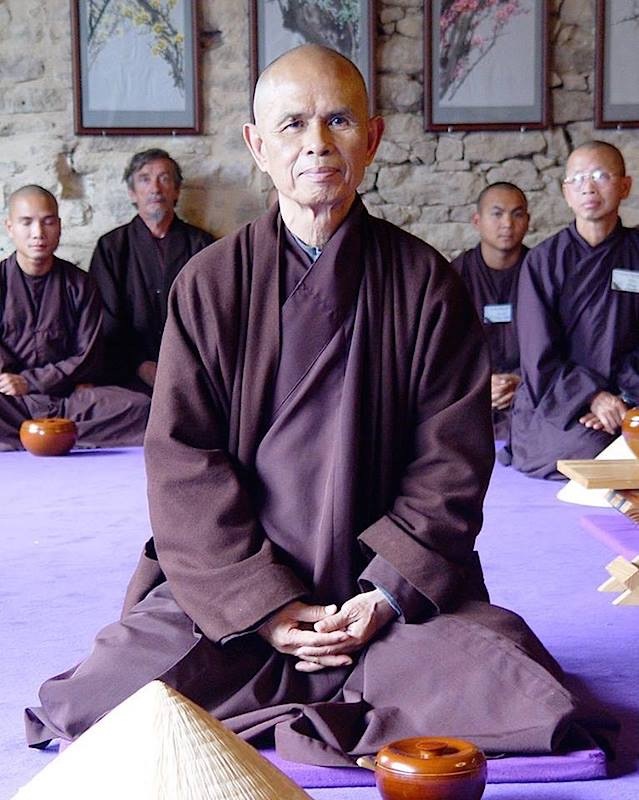by Pam Marraccini | anger, awareness, breathing, Buddha, Buddhist psychology, compassion, concentration, consciouness, deep looking, heart, ignorance, joy, love, meditation, mindfulness, nonduality, seeds, suffering, Thich Nhat Hanh, understanding

Understanding is the fruit of meditation. When we practice deep looking directed toward the heart of reality, we receive understanding, we receive the wisdom that makes us free. If there is deep pain within you, meditate.
Meditating is not trying to run away, trying to ignore the presence of the pain, but on the contrary, it is looking at it face-to-face. You have to practice deep looking directed toward the nature of this pain because for Buddhists, we are joy, but we are also pain; e are understanding, but we are also ignorance. Meditating is not transforming oneself into a battlefield where one side is fighting another, where good fights against evil. This is not Buddhist meditation. Buddhist meditation is based on the principle of non-duality. This means that if we are mindfulness, if we are love, we are also ignorance, we are also suffering, and there is no reason to suppress anything at all.
When the seed of anger manifests on the level of our conscious mind, our immediate awareness, it is because the seed of anger is in the depths of our consciousness, and then we begin to suffer. Our immediate awareness is something like our living room. The task of the meditator is not to chase away or to suppress the energy of anger that is there but rather to invite another energy that will be able to care for the anger.
You can use the method of mindful breathing to make the seed of this other energy grow inside of you. It will then manifest in the form of energy, and this energy will embrace your energy of anger like a mother taking a baby in her arms. Then there is only tenderness, there is no fighting with, or discriminating against, the pain. The purpose of the practice of mindful breathing is to help to give birth to this precious energy called mindfulness and to keep it alive.
… Mindfulness is like a light, enabling concentration to really be there, and that also makes it possible for us to look deeply into the heart of things. From this looking deeply is born deep vision, understanding. Mindfulness brings concentration, understanding, love and freedom.
…when the energy of compassion and love touches us, healing establishes itself.
In Buddhism, we say that mindfulness is the energy of the Buddha. The seed of mindfulness is the baby Buddha that is in us. This precious seed can be buried very deeply under several layers of suffering and ignorance. We begin by looking for, by touching this seed of mindfulness, and everybody knows that all of us have this precious seed in us.
When you drink water, if you are aware of the fact that you are drinking water, mindfulness is there. Mindfulness is the energy that makes it possible for us to be aware of what is happening in the present moment.
When you breathe in and you are aware that you are breathing in, mindfulness is there. Mindfulness is always mindfulness of something. When you are angry and yu know that you are angry, mindfulness is there. Anger is one energy, mindfulness is another, and this second kind of energy arises in order to care for the first like a mother caring for her baby.
by Pam Marraccini | afflictions, anger, breathing, Buddhist psychology, compassion, concentration, energy, inner child, meditation, mental formation, mind consciousness, mindfulness, nonduality, seed, store consciousness, Thich Nhat Hanh, walking meditation
by Thich Nhat Hanh
CHAPTER ONE
The Energy of Mindfulness
The energy of mindfulness is the salve that will recognize and heal the child within. But how do we cultivate this energy?
Buddhist psychology divides consciousness into two parts. One part is mind consciousness and the other is store consciousness. Mind consciousness is our active awareness. Western psychology calls it “the conscious mind.” To cultivate the energy of mindfulness, we try to engage our active awareness in all our activities and be truly present with whatever we are doing. We want to be mindful as we drink our tea or drive through the city. When we walk, we want to be aware that we are walking. When we breathe, we want to be aware that we are breathing.
Store consciousness, also called root consciousness, is the base of our consciousness. In Western psychology it’s called “the unconscious mind.” It’s where all our past experiences are stored. Store consciousness has the capacity to learn and to process information.
Often our mind is not there with our body. Sometimes we go through daily activities without mind consciousness being involved at all. We can do many things by means of store consciousness alone, and mind consciousness can be thinking of a thousand other things. For example, when we drive our car through the city, mind consciousness may not be thinking about driving at all, but we still reach our destination without getting lost or having an accident. That is our store consciousness operating on its own.
Consciousness is like a house in which the basement is our store consciousness and the living room is our mind consciousness. Mental formations like anger, sorrow, or joy rest in the store consciousness in the form of seeds (bija). We have a seed of anger, despair, discrimination, fear, a seed of mindfulness, compassion, a seed of understanding, and so on. Store consciousness is made of the totality of the seeds, and it is also the soil that preserves and maintains all the seeds. The seeds stay there until we hear, see, read, or think of something that touches a seed and makes us feel the anger, joy, or sorrow. This is a seed coming up and manifesting on the level of mind consciousness, in our living room. Now we no longer call it a seed, but a mental formation.
When someone touches the seed of anger by saying something or doing something that upsets us, that seed of anger will come up and manifest in mind consciousness as the mental formation (cittasamskara) of anger. The word “formation” is a Buddhist term for something that’s created by many conditions coming together. A marker pen is a formation; my hand, a flower, a table, a house, are all formations. A house is a physical formation. My hand is a physiological formation. My anger is a mental formation. In Buddhist psychology we speak about fifty-one varieties of seeds that can manifest as fifty-one mental formations. Anger is just one of them. In store consciousness, anger is called a seed. In mind consciousness, it’s called a mental formation.
Whenever a seed, say the seed of anger, comes up into our living room and manifests as a mental formation, the first thing we can do is to touch the seed of mindfulness and invite it to come up too. Now we have two mental formations in the living room. This is mindfulness of anger. Mindfulness is always mindfulness of something. When we breathe mindfully, that is mindfulness of breathing. When we walk mindfully, that is mindfulness of walking. When we eat mindfully, that is mindfulness of eating. So in this case, mindfulness is mindfulness of anger. Mindfulness recognizes and embraces anger.
Our practice is based on the insight of nonduality – anger is not an enemy. Both mindfulness and anger are ourselves. Mindfulness is not there to suppress or fight against anger, but to recognize and take care. It’s like a big brother helping a younger brother. So the energy of anger is recognized and embraced tenderly by the energy of mindfulness.
Every time we need the energy of mindfulness, we just touch that seed with our mindful breathing, our mindful walking, smiling, and then we have the energy ready to do the work of recognizing, embracing, and later on looking deeply and transforming. Whatever we’re doing, whether its cooking, sweeping, washing, walking, being aware of breathing, we can continue to generate the energy of mindfulness, and the seed of mindfulness in us will become strong. Within the seed of mindfulness is the seed of concentration. With these two energies, we can liberate ourselves from afflictions.


